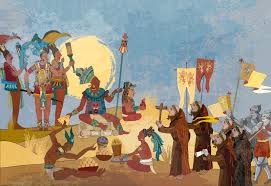Spanish silver fueled European empires and global trade, transforming the world economy during the 16th and 17th centuries. The massive influx of silver from the mines of Potosí in Bolivia and Zacatecas in Mexico turned Spain into the dominant superpower of the era, financing its military campaigns, colonial expansions, and cultural renaissance. Beyond Spain, this silver became the backbone of a burgeoning global trade network, linking the Americas, Europe, and Asia in an unprecedented flow of wealth and goods. Yet, this economic boom came with profound consequences—widespread inflation, environmental destruction, and the exploitation of labor—shaping the trajectory of empires and economies for centuries to come.

Silver and the Rise of Spain as a Superpower
- Financing the Spanish Empire:
- The flood of American silver into Spain provided the financial resources to sustain its global empire.
- Silver funded Spain’s military campaigns, including wars against the Ottoman Empire, Protestant states during the Reformation, and colonial expansion in the Americas, Africa, and Asia.
- The Spanish Armada and the construction of Spain’s vast naval fleet were made possible by silver wealth.
- Cultural Flourishing in Spain:
- The Spanish Renaissance, marked by achievements in art, architecture, and literature, was fueled by the wealth from silver mines.
- Iconic figures like El Greco, Diego Velázquez, and Miguel de Cervantes thrived in this era, often patronized by the wealthiest elite.
- Economic Challenges:
- While silver brought immense wealth, it also led to economic imbalances. The influx of silver caused inflation throughout Europe, known as the Price Revolution, eroding the purchasing power of money.
- Spain became overly reliant on silver imports, neglecting domestic industries and agriculture, which left its economy vulnerable to collapse when silver supplies declined.
Silver as the Engine of Global Trade
Spain’s silver fueled more than its empire—it became the foundation of a burgeoning global economy.
- The Manila Galleon Trade:
- Spain established the galleon trade route between Acapulco, Mexico, and Manila in the Philippines. This route connected the Americas, Europe, and Asia, facilitating the exchange of silver for luxury goods like Chinese silk, porcelain, and spices.
- Silver became the preferred medium of exchange in Asia, especially in China, where the Ming Dynasty’s tax reforms required payments in silver.
- Silver’s Role in European Trade:
- European powers like Portugal and the Netherlands also benefitted indirectly from Spain’s silver. The influx of silver enabled Spain to purchase goods and services from its rivals, strengthening European trade networks.
- Cities like Antwerp and Amsterdam emerged as financial and trading hubs, fueled by the availability of Spanish silver.
- The “Silver Drain” to Asia:
- An estimated two-thirds of all American silver mined in the 16th and 17th centuries ended up in Asia, particularly China.
- This flow of silver enabled Europe to import high-value goods from Asia while simultaneously integrating Asian economies into the global trade system.
Silver’s Influence on European Rivals
The wealth generated by Spanish silver spurred competition among European powers:
- Portugal: Strengthened its trade routes in the Indian Ocean, leveraging its colonies in Africa and Asia to secure access to spices and other valuable commodities.
- England: Used its naval power to raid Spanish ships carrying silver, with privateers like Sir Francis Drake enriching England through piracy.
- The Netherlands: Capitalized on the Spanish focus on silver by building robust financial institutions, such as the Amsterdam Stock Exchange and the Bank of Amsterdam, which became global financial centers.
The Price Revolution and Silver’s Global Consequences
- Inflation in Europe:
- The sudden influx of silver into Europe caused widespread inflation, as the abundance of currency reduced its purchasing power.
- Wages stagnated while the prices of goods rose, exacerbating economic inequality across the continent.
- Integration of Global Markets:
- Silver connected regions of the world like never before, creating the first truly global trade networks.
- It allowed Europe to dominate international trade while drawing Asian economies deeper into the global system.
- Environmental and Human Costs:
- The environmental impact of silver mining, particularly mercury pollution from the patio process, devastated ecosystems in the Americas.
- The human toll was immense, with forced labor systems like the mita leading to the suffering and deaths of countless indigenous and African workers.
Conclusion: Silver as the Lifeblood of Empire and Trade
Spanish silver was the foundation upon which the wealth of empires and the global economy were built. It financed Spain’s military ambitions, enabled cultural flourishing, and linked Europe, the Americas, and Asia in a vast web of trade. Yet, this wealth came at a cost—rising inflation, environmental destruction, and human suffering. The era of Spanish silver underscores the dual-edged nature of economic power, as it brought both immense prosperity and profound challenges to the world.
